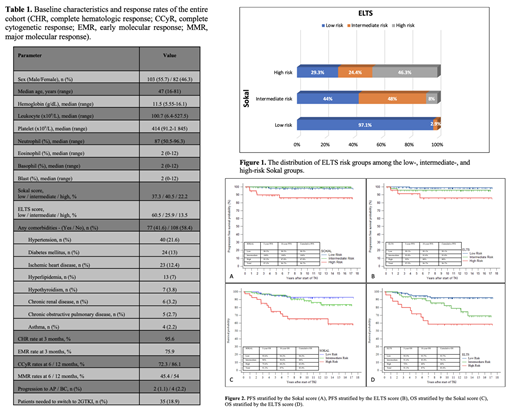Abstract
Introduction and Objectives: For patients (pts) with chronic myeloid leukemia in chronic phase (CML-CP), four baseline prognostic scores are commonly used including the Sokal score and the most recently introduced EUTOS long-term survival (ELTS) score. The ELTS score was shown to be superior to the Sokal score for predicting survival. The aim of the study is to evaluate the value of ELTS score on predicting disease progression and survival in Turkish pts with CML-CP.
Material and Method: Demographic, laboratory and clinical features, disease responses to tyrosine kinase inhibitor (TKI) therapy and survival of CML-CP pts, who received upfront imatinib (IM) between 2003 and 2018 were analyzed retrospectively. Treatment responses were reevaluated according to European LeukemiaNet 2013 recommendations. Risk groups analysis, discrimination and hazard ratios (HRs) were evaluated with Cox regression and Kaplan-Meier survival analysis. Receiver operating characteristic (ROC) analysis was performed to examine the effects of scores on predicting overall survival (OS) and progression-free survival (PFS).
Results: A total of 185 pts were included, of which 103 (55.7%) were male and median age was 47 years (range, 16 - 81 years) (Table 1). The percentages of pts with low-, intermediate-, and high-risk ELTS scores were 60.5%, 25.9%, and 13.5%, respectively. For the Sokal score, these percentages were 37.3%, 40.5%, and 22.2% respectively. For Sokal high-risk pts, only 46.3% were classified as high-risk according to the ELTS score. Similarly, 44% of pts with intermediate Sokal risk had low-risk ELTS score (Fig. 1). Seventy-seven pts (41.6%) had at least one comorbidity, and the most common comorbidities were hypertension (21.6%), diabetes mellitus (13%), and ischemic heart disease (12.4%) (Table 1). The median durations of IM therapy and follow-up were 2728 (range, 14 - 6320 days) and 3473 (range, 71 - 6320 days) days, respectively. Complete hematologic and early molecular (BCR-ABL1 IS <10% at 3 months) responses at 3 months were 95.6% and 75.9%, respectively. Complete cytogenetic and major molecular response rates at 6 and 12 months were 72.3% and 86.1% and 45.4% and 54%, respectively. Thirty-five pts (18.9%) switched to second-generation TKI therapy and 6 pts (3.2%) progressed to advanced-phase disease during the follow-up (Table 1). For PFS, with reference to the low-risk Sokal score, the HR of high-risk groups was 9.301 (95% CI: 1.086-79.656, p=0.042) (Fig. 2A). Similarly, with reference to the low-risk ELTS score, the HR of intermediate- and high-risk groups were 4.744 (95% CI: 0.43-52.314, p=0.204) and 14.642 (95% CI: 1.523-140.791, p=0.020) (Fig. 2B). Regarding OS, with reference to the low-risk Sokal score, the HR of the intermediate- and high-risk groups were 1.835 (95% CI: 0.564-5.964, p=0.313) and 6.412 (95% CI: 2.11-19.489, p=0.001), respectively (Fig. 2C). With reference to the low-risk ELTS score, the HR of the intermediate- and high-risk groups were, 3.263 (95% CI: 1.242-8.576, p=0.016) and 7.258 (95% CI: 2.762-19.074, p<0.001) respectively (Fig. 2D). In the ROC analysis, the ELTS score was superior than the Sokal risk score for both predicting PFS (AUC=0.820 vs. AUC=0.818) and OS (AUC=0.762 vs. AUC=0.744). During the follow-up, 27 (14.6%) pts died, of which 6 died due to CML progression and causes of death were unrelated to CML in 21.
Conclusion: In our study, we showed that the ELTS score could successfully predict high-risk pts compatible with the literature. With higher hazard ratios and better risk group stratifications, the ELTS score outperformed the Sokal score. The ELTS score can help clinicians to better discriminate poor prognostic pts and can promote optimal treatment strategies for these pts with potentially worse prognosis.
No relevant conflicts of interest to declare.


This feature is available to Subscribers Only
Sign In or Create an Account Close Modal